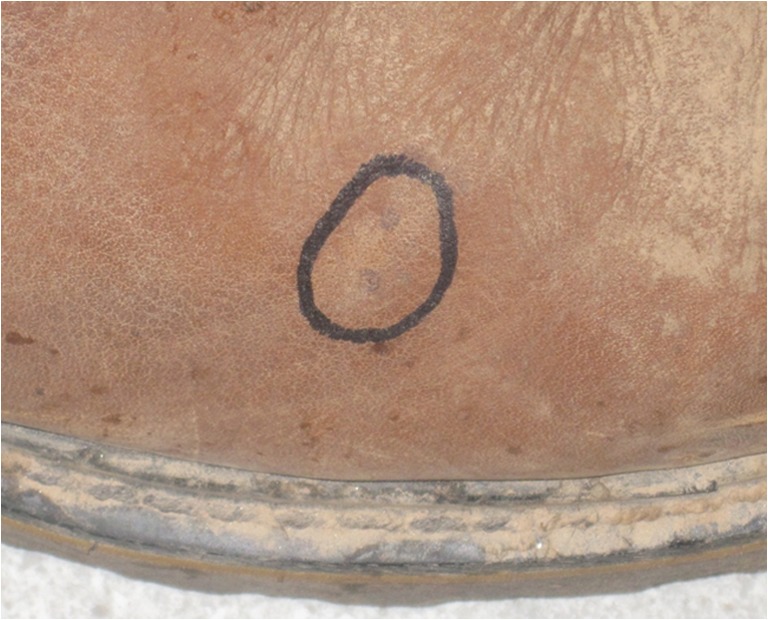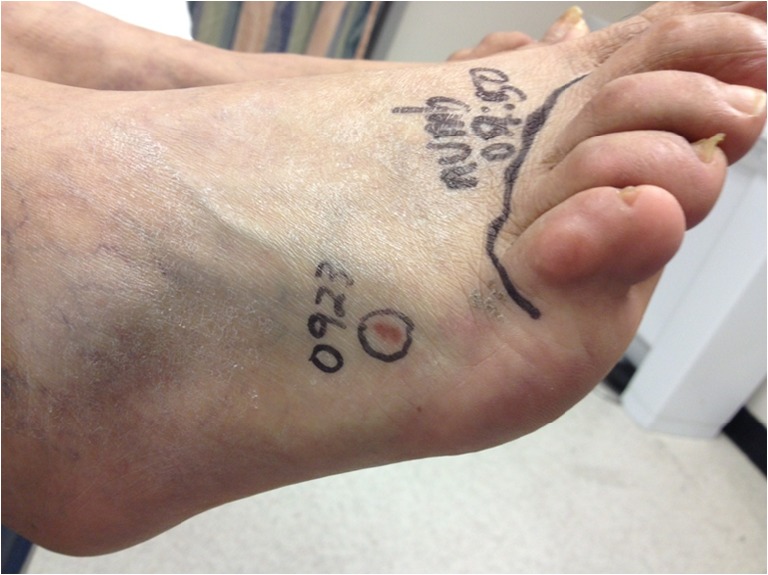Abstract
Introduction
North American rattlesnake envenomations typically result in local tissue injury and hematologic derangements. Neurotoxicity is uncommon but when present often manifests as fasciculations and paresthesias. Neurotoxicity following Sidewinder (Crotalus cerastes) envenomation has not been previously reported.
Case Report
A 56-year-old man bitten on the right foot developed painful paresthesias, weakness and fasciculations of the right lower extremity, and involuntary muscle contractions of the anterior thigh. Local tissue effects and hemotoxicity never developed. The patient was discharged 5 days after the bite with resolution of fasciculations but continued to have right-sided weakness. The snake was identified as a Sidewinder, C. cerastes, by the patient and two independent herpetologists.
Conclusion
This is the first reported case of a Sidewinder rattlesnake envenomation resulting in neurotoxicity.
Electronic supplementary material
The online version of this article (doi:10.1007/s13181-013-0373-0) contains supplementary material, which is available to authorized users.
Keywords: Neurotoxicity, Sidewinder, Rattlesnake, Crotalus cerastes, Envenomation
Introduction
North American rattlesnake envenomations often result in local tissue injury and hematologic effects including thrombocytopenia and coagulopathy. Neurotoxicity following rattlesnake envenomation is much less common even though venom of all species of crotalids contains neurotoxin [1]. The Mojave rattlesnake, Crotalus scutulatus, is best known for its neurotoxic venom. Venom of this species may contain Mojave toxin, a β-neurotoxin responsible for paralysis and respiratory failure in envenomed victims [2]. In general, Mojave toxin is not found in the venom of other North American rattlesnake species, yet neurotoxicity has also been reported following envenomation by the Timber (Crotalus horridus), Western Diamondback (Crotalus atrox), Southern Pacific (Crotalus oreganus helleri), and Midget Faded (Crotalus oreganus concolor) rattlesnakes [1, 3–6]. Neurotoxicity following envenomation by the Sidewinder rattlesnake, Crotalus cerastes, has not previously been reported. We describe such a case.
Case Report
A 56-year-old healthy man, without previous history of snakebite, was working in southwestern Arizona when he felt something bite him on his right foot through his leather boot (Fig. 1). He saw a rattlesnake, which he described as a 3-foot-long Sidewinder (C. cerastes), possessing “horns” and moving as if taking sideways steps. The snake was captured by a co-worker and photographed, and the photograph was forwarded to two independent herpetologists who confirmed the species to be a Sidewinder.
Fig. 1.

Leather boot worn by the patient with two penetrating fang marks circled
The patient immediately developed burning pain in his foot along with numbness of the foot and toes distal to the bite site. Within minutes, the pain spread proximally to the knee. The patient then developed nausea and dyspnea, which resolved prior to helicopter transport from the scene 60 min after the envenomation.
The patient arrived in the emergency department 2 h after the snakebite reporting 8/10 pain in his right foot and leg. Vital signs on arrival included a blood pressure of 125/76 mmHg, heart rate of 72 bpm, oxygen saturation 97 % on room air, and afebrile. Notable findings on physical examination included a general ill appearance, a small ecchymotic lesion on the dorsal lateral aspect of the right foot without swelling (Fig. 2), weakness of the right toes, decreased sensation of the distal half of the right foot including the toes, and pronounced fasciculations of the anterior thigh musculature (Online resource 1). The remainder of the physical examination was benign. A puncture through the skin was not visible at the bite site. Initial laboratory values including prothrombin time, fibrinogen, platelet count, and creatinine phosphokinase were in the normal range.
Fig. 2.

Right foot of patient showing envenomation site (circled) with a small ecchymotic lesion (1 × 0.7 cm) and minimal swelling. He later developed a scab in this area
In the emergency department, the patient received a total of 8 mg of intravenous morphine for acute pain, without resolution. The patient did not receive antivenom. The decision to withhold antivenom was based on normal platelets and coagulation studies, lack of swelling, and lack of evidence to support resolution of venom-induced fasciculations with antivenom. The patient was admitted for observation and laboratory monitoring. On day two of hospitalization, the patient had progression of his symptoms with burning and tingling pain of the entire right lower extremity up to the groin, 4/5 weakness of the right upper and lower extremity, and involuntary contractions of different muscle groups of the right thigh. The patient was nauseated, anorexic, and unable to ambulate without assistance. He developed bilateral conjunctival injection and ptosis. He was moved to a telemetry unit for closer monitoring along with serial negative inspiratory force (NIF) measurements, as there was concern for progression of weakness to include muscles of respiration. On day three of hospitalization, the patient’s NIF decreased to −50 cmH2O. It returned to normal within 12 h. Respiratory failure never developed. Over the next day, muscle contractions and fasciculations continued, but with diminishing frequency and intensity, and paresthesias improved. The patient further improved on day four of hospitalization; although he continued to have poor appetite and required a walker to ambulate. On day five, he was discharged home with persistent right upper and lower extremity weakness, distal right foot numbness, and improving paresthesias. He never developed coagulopathy or thrombocytopenia.
The patient was seen in our follow-up clinic 10 days post-envenomation. He reported intermittent epigastric pain resulting in poor oral intake, atypical chest pain, and persistent mild paresthesias. His right-sided weakness had improved but required a cane to assist with ambulation. He did not return for further scheduled electromyography or follow-up visits.
Discussion
The Sidewinder rattlesnake, C. cerastes, is found in parts of Nevada, Utah, California, Arizona, and northern Mexico. In Arizona, the Sidewinder inhabits the low desert areas of the southwestern region of the state and has a limited range in northwest regions to an elevation of about 2,800 feet [7, 8]. The Sidewinder is unique among rattlesnakes in that it possesses supraocular horns and “sidewinding” locomotion. Clinical effects following envenomation are generally similar to, although possibly less severe than, those occurring after envenomation by other North American rattlesnake species. Effects may include local pain, swelling, thrombocytopenia, and coagulopathy [9]. Neurotoxic findings after Sidewinder envenomation have not been reported previously.
In North America, the rattlesnake best known for its neurotoxic venom is the Mojave, C. scutulatus. Envenomation may lead to paresthesias, weakness, fasciculations, cranial nerve paresis, and respiratory paralysis [1, 2]. However, fasciculations, in some cases severe enough to lead to respiratory failure, have also been reported following envenomation by other rattlesnake species, including the Timber (C. horridus), Western Diamondback (C. atrox), Southern Pacific (C. oreganus helleri), and Midget Faded (C. oreganus concolor) rattlesnake [1, 3–6].
Although fasciculations are not a frequent observation in envenomed patients, a review of cases reported to the California state poison control system identified 47 cases of snakebite over a 4-year period in which fasciculations were reported [6]. In the series, fasciculations in the shoulder and chest area were associated with development of respiratory failure. Although the specific species responsible for fasciculations were not identified, other reports from California have associated the Southern Pacific rattlesnake (C. oreganus helleri) with development of severe fasciculations and respiratory failure [5, 10]. Such cases prompted an investigation, which lead to the discovery that Mojave toxin was present in the venom of Southern Pacific rattlesnakes sampled from one geographic region [11].
In Arizona, neurotoxic effects are rarely reported following rattlesnake envenomation. The Mojave rattlesnake inhabits most of western and southern Arizona [7, 8], but some Mojave populations do not possess Mojave toxin [12]. In geographical regions without neurotoxic Mojave rattlesnakes, fasciculations are more often associated with bites by the Western Diamondback, C. atrox. Another neuromuscular finding, myokymia, has also been reported following snake envenomation in Arizona. Myokymia has been characterized as spontaneous, involuntary ripples of muscle fibers. Lovecchio et al. reported two cases of snakebite which occurred in the Lake Powell region of northern Arizona which resulted in myokymia [4]. One snake was identified as a Midget Faded rattlesnake, C. oreganus concolor, and the other was not identified [4]. Our patient did not exhibit myokymia. His envenomation occurred in an area of southwestern Arizona inhabited by the Sidewinder, Western Diamondback, and Mojave rattlesnakes. While it is theoretically possible that this particular Sidewinder possessed Mojave toxin, it seems more likely that the fasciculations were caused by another neurotoxic venom component.
It is unknown whether administration of antivenom would have led to the improvement or reversal of neurotoxicity in our patient. Crotalidae polyvalent immune Fab (FabAV), currently the only FDA-approved antivenom available, is produced using the venom of four North American crotaline species [13]. These include the Eastern Diamondback (C. adamanteus), Western Diamondback (C. atrox), Mojave (C. scutulatus), and Cottonmouth (Agkistrodon piscivorus). Experience with FabAV in reversing venom-induced neurotoxicity is mixed. Clark et al. reported success in reversing fasciculations in two patients with C. atrox envenomations and in one patient with C. scutulatus envenomation [1]. In contrast, Richardson et al. reported failure of FabAV to reverse fasciculations in two patients with C. oreganus helleri envenomation [5].
At the time of our patient’s presentation, we chose not to administer FabAV after a risk benefit analysis. We considered the non-life threatening nature of the patient’s neurotoxic symptoms at the time of presentation, lack of swelling, hematologic and systemic toxicity, lack of evidence for FabAV efficacy in reversing neurotoxicity, the risks of reaction to FabAV, and treatment cost. We did not anticipate the continued worsening and persistence of clinical effects in this patient and in the future would consider a trial of antivenom in a similar patient.
Conclusion
Envenomation by the Sidewinder rattlesnake, C. cerastes, may be associated with neurotoxic effects, including paresthesias, fasciculations, and weakness. Symptoms may progress in the days following envenomation.
Electronic supplementary material
Fasciculations of the anterior thigh following envenomation by a Sidewinder rattlesnake (Crotalus cerastes) (MOV 13094 kb)
Acknowledgments
Conflict of interest
The authors have no conflicts of interest to disclose.
References
- 1.Clark RF, Williams SR, Nordt SP, et al. Successful treatment of Crotalid-induced neurotoxicity with a new polyspecific Crotalid fab antivenom. Ann Emerg Med. 1997;30:54–57. doi: 10.1016/S0196-0644(97)70111-2. [DOI] [PubMed] [Google Scholar]
- 2.Jansen PW, Perkin RM, Van Stralen D. Mojave rattlesnake envenomation: prolonged neurotoxicity and rhabdomyolysis. Ann Emerg Med. 1992;21:322–325. doi: 10.1016/S0196-0644(05)80898-4. [DOI] [PubMed] [Google Scholar]
- 3.Brick JF, Gutmann L, Brick J, et al. Timber rattlesnake venom-induced myokymia: evidence for peripheral nerve origin. Neurology. 1987;37:1545–1546. doi: 10.1212/WNL.37.9.1545. [DOI] [PubMed] [Google Scholar]
- 4.Lovecchio F, Pizon AF, Wallace KL, et al. Myokymia after snake envenomation in Arizona. Wilderness Environ Med. 2005;16:116–117. doi: 10.1580/1080-6032(2005)16[116:MASEIA]2.0.CO;2. [DOI] [PubMed] [Google Scholar]
- 5.Richardson WH, Goto CS, Gutglass DJ, et al. Rattlesnake envenomation with neurotoxicity refractory to treatment with crotaline Fab antivenom. Clin Tox. 2007;45:472–475. doi: 10.1080/15563650701338187. [DOI] [PubMed] [Google Scholar]
- 6.Vohra R, Cantrell FL, Williams SR. Fasciculations after rattlesnake envenomations. Clin Tox. 2008;46:117–121. doi: 10.1080/15563650701638925. [DOI] [PubMed] [Google Scholar]
- 7.Brennan TC. 2008; http://www.reptilesofaz.org/Snakes-Subpages/h-c-cerastes.html Accessed November 14, 2013.
- 8.Arizona Game and Fish Department. 2013; http://www.azgfd.gov/w_c/arizona-rattlesnakes.shtml#4 Accessed November 14, 2013.
- 9.Wingert WA, Chan L. Rattlesnake bites in southern California and rational for recommended treatment. West J Med. 1988;148:37–44. [PMC free article] [PubMed] [Google Scholar]
- 10.Bush SP, Siedenburg E. Neurotoxicity associated with suspected Southern Pacific rattlesnake (Crotalus viridis helleri) envenomation. Wild Env Med. 1999;10:247–249. doi: 10.1580/1080-6032(1999)010[0247:NAWSSP]2.3.CO;2. [DOI] [PubMed] [Google Scholar]
- 11.French WJ, Hayes WK, Bush SP, et al. Mojave toxin in venom of Crotalus helleri (Southern Pacific Rattlesnake): molecular and geographic characterization. Toxicon. 2004;44:781–791. doi: 10.1016/j.toxicon.2004.08.008. [DOI] [PubMed] [Google Scholar]
- 12.Wooldridge BJ, Pineda G, Banuelas-Ornelas JJ, et al. Mojave rattlesnakes (Crotalus scutulatus scutulatus) lacking the acidic subunit DNA sequence lack Mojave toxin in their venom. Comp Biochem Phys. 2001;130:169–179. doi: 10.1016/S1096-4959(01)00422-5. [DOI] [PubMed] [Google Scholar]
- 13.CroFab® Crotalidae Polyvalent Immune Fab (ovine). Prescribing information. http://www.fda.gov/downloads/BiologicsBloodVaccines/BloodBloodProducts/ApprovedProducts/LicensedProductsBLAs/FractionatedPlasmaProducts/ucm117573.pdf Accessed November 14, 2013.
Associated Data
This section collects any data citations, data availability statements, or supplementary materials included in this article.
Supplementary Materials
Fasciculations of the anterior thigh following envenomation by a Sidewinder rattlesnake (Crotalus cerastes) (MOV 13094 kb)


